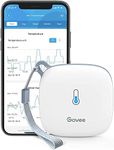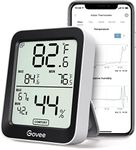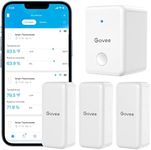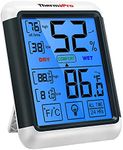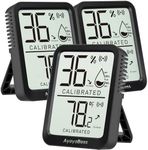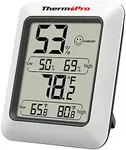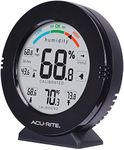Buying Guide for the Best hygrometers
Choosing the right hygrometer is all about understanding where and how you plan to use it. Hygrometers measure the humidity in the air, which is important for everything from keeping your home comfortable to protecting musical instruments, cigars, or even monitoring greenhouses. Before you buy, think about whether you need a device for indoor or outdoor use, how accurate you need it to be, and whether you want extra features like temperature readings or connectivity to your phone. Knowing your specific needs will help you focus on the features that matter most for your situation.AccuracyAccuracy tells you how close the hygrometer's readings are to the actual humidity level. This is important because inaccurate readings can lead to problems, like mold growth or damage to sensitive items. Accuracy is usually given as a percentage, such as ±2% RH (relative humidity). For general home use, a small margin of error is usually fine, but if you need to monitor humidity for things like a humidor or a greenhouse, look for a model with higher accuracy. Think about how critical precise humidity is for your use—if it's just for comfort, you can be more flexible, but for sensitive environments, prioritize accuracy.
Display TypeThe display type refers to how the hygrometer shows you the humidity readings. Some have analog dials, while others use digital screens. Analog displays are simple and don't need batteries, but digital displays are easier to read and often show more information, like temperature or historical data. If you want quick, clear readings or extra features, digital is usually better. If you prefer simplicity and reliability, analog might be the way to go. Consider where you'll place the hygrometer and how often you'll check it to decide which display suits you best.
Measurement RangeMeasurement range is the span of humidity levels the hygrometer can detect, usually shown as a percentage (for example, 10% to 99% RH). This matters because some environments, like saunas or greenhouses, can have very high or low humidity. For most homes, a standard range is enough, but if you need to monitor extreme conditions, make sure the device covers those levels. Think about the environment where you'll use the hygrometer and choose a range that fits your needs.
CalibrationCalibration is the ability to adjust the hygrometer to ensure its readings stay accurate over time. Some hygrometers can be recalibrated, while others cannot. This is important if you need long-term accuracy, especially for things like cigar storage or scientific use. If you just want to monitor general home humidity, calibration may not be as critical. If you need ongoing precision, look for a model that allows easy calibration.
Additional FeaturesMany hygrometers come with extra features, such as temperature measurement, data logging, smartphone connectivity, or alerts when humidity goes out of a set range. These can make monitoring easier and more convenient, especially if you want to track changes over time or get notified of problems. Decide which features would actually help you—if you just want to check humidity occasionally, you may not need extras, but if you want detailed tracking or remote monitoring, look for these advanced options.
Portability and Mounting OptionsPortability and mounting options refer to how easy it is to move the hygrometer or attach it to a wall, shelf, or other surface. Some are designed to sit on a table, while others can be mounted or even carried in a pocket. If you need to monitor different rooms or want a permanent installation, consider the size and mounting choices. Think about where and how you'll use the device to pick the right style for your needs.

